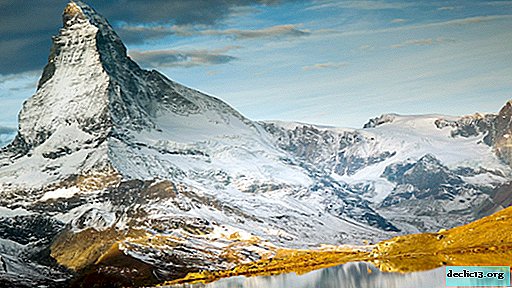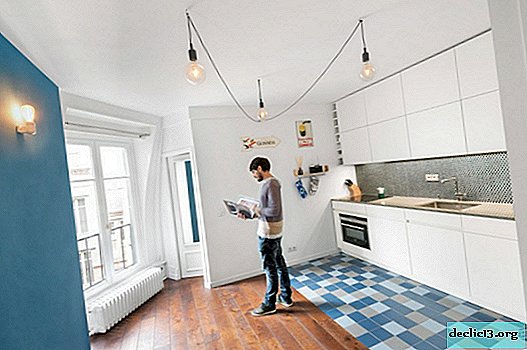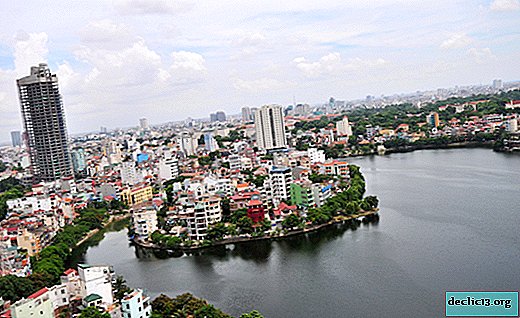Mount Matterhorn in Switzerland - the deadly peak of the Alps
Mount Matterhorn is one of the most recognizable peaks in the world. If you have never been lucky enough to visit the border of Switzerland and Italy, you will still easily recognize the characteristic shape of the mountain in the form of a tetrahedral pyramid. Matterhorn Peak annually attracts hundreds of thousands of tourists who come just to look at it and about 3 thousand climbers who want to conquer the summit. However, Matterhorn Mountain in Switzerland is not only beautiful, but also dangerous. People die here regularly, so you need to carefully prepare and evaluate your strength before the trip. In any case, no tourist will be left disappointed.

Photo: Matterhorn Mountain.
General information
 Matterhorn South Wall
Matterhorn South WallLet's start with the information - where is Mount Matterhorn. The attraction is located in the Peninsky Alps and runs between two states - Switzerland and Italy. The slope in the south is located on Italian territory, the other three sides belong to Switzerland.
The Italian name of the mountain - Monte Cervino - comes from the French Mons Servinus and means "forest mountain", and from German the name "Matterhorn" is translated as "meadow" (Matte) and "peak" (Horn)
Interesting fact! The peak is located far from other peaks of the Alps, this makes it possible to see the mountain and feel its magnetism.
The height of the Matterhorn is almost 4.48 km (4478 m, to be exact). Steep slopes and rockiness hide behind the outward appeal. That is why for a long time the attraction in Switzerland did not obey climbers.
Two peaks are clearly visible in the mountain profile, located a hundred meters from each other. The state border runs directly between the peaks, respectively, one is called Italian, and the second - Swiss.
Good to know! The height of the Italian peak is only 1 m below the Swiss one.
The mountain in the Alps is notable for its strict, geometric proportions. Outwardly, it resembles a pyramid of irregular shape, the edges of which are located in the directions of the cardinal points.

In the cold season, the mountain is completely covered by glaciers and snows. However, in the summer the sun melts snow, a small amount remains only on the eastern and northeastern side.
Good to know! The mountain in the Alps is characterized by steep slopes, for this reason rockfalls and avalanches often occur here.
Practical information
 Zermatt
ZermattTourists stay in one of the villages:
- in Switzerland - the town of Zermatt;
- in Italy - the settlement of Bray Cervinia.
Theodul Pass divides the villages. Ski slopes are laid at an altitude of 4 km, but real extreme sports and professionals prefer to climb higher in the Alps.

Photo: Matterhorn - a mountain in the Alps.
Historical facts

At the foot of the Matterhorn in the Alps, the first people settled during the Roman Empire. In the 1st century BC Theodul Pass was used for trade links between north and south of Europe.
Interesting to know! Ancient tribes did not dare to settle on the slopes, because they believed that this is the habitat of the devil. Most likely, the belief arose due to the frightening appearance of the mountain and frequent avalanches.
In the 19th century, a movement of like-minded people appeared in England who wanted to conquer the most dangerous slopes. Groups of climbers went to all the slopes of the Alps, but even Mont Blanc obeyed people faster than the top of the Matterhorn. Those who wanted to get to the peak gathered at the foot many times, but did not dare to climb.
Climbing the top of the Matterhorn
Given the particular geographical location of the mountain - in Switzerland and Italy - there are two ways to travel - from the territory of each of the states.

Due to its unusual shape - an almost equilateral pyramid - the mountain has attracted climbers for many centuries and has a rich history with unusual and tragic facts. The hiking route along the slopes requires:
- rope skills;
- rock mobility skills;
- the ability to organize insurance;
- compliance with safety regulations.
Before climbing, you must pass a training course, and take the help of a guide on the road.
It is important! From the side of Switzerland, the route is as simple as possible, cables are hung in the most dangerous places, insurance is organized, huts for recreation are equipped, if during the ascent of tourists the weather falls, you can wait it out in an emergency shelter.

The height of the mountain in the Alps is about 4.48 km, so the question of preparing for the conquest of the Matterhorn peak in Switzerland should be worked out in advance and make sure that you have enough strength and endurance for this difficult test. You should also pay attention to acclimatization in the mountains. In fine weather, dozens of tourists can be found on narrow sections of climbing routes, so guides recommend that you exercise maximum caution and attention.
What to fear
The main danger of the Matterhorn mountain in Switzerland is unpredictable weather. The clouds here are low, peaks enveloping, forming a stable, dense fog. Sometimes, at a distance of one meter, nothing is visible. Weather can change within a quarter of an hour. In addition to fog, climbers lurk storms and snowfalls. Given the speed with which the weather changes, it is very difficult to find shelter from the weather.


The greatest danger in the Alps is rockfalls. In some cases, tourists provoke them, and sometimes stones fall off under the weight of glaciers. Experts call this fact surprising - despite numerous avalanches and stone caving, the mountain has not changed its appearance over the centuries.
What is required for climbing

- A capacious backpack with a volume of 40 to 60 liters.
- Mat at least 12 mm thick.
- A sleeping bag in which it will be comfortable to spend the night at a temperature of +10 degrees.
- Special clothes and shoes - down jacket, fleece jacket, storm jacket, storm or trekking pants, a set of thermal underwear, climbing boots. If you plan to climb in the summer, it is recommended that you take a replaceable set of linen, spare t-shirts and shorts. Also required a hat, buff, socks, gloves.
- Glasses or mask with UV protection (at least 3 factors).
- Trekking sticks will help protect your knees from injuries.
- Head Torch.
- Sunscreen (factor of at least 50), hygienic lipstick.
- Dishes - a plate, spoon, mug, knife.
- Hygiene items - toothpaste and brush, soap, towel, comb, other necessary things.
- First-aid kit - drugs are selected individually, but be sure to take a bactericidal patch.
- Climbing accessories - cats, ice ax, helmet, insurance, carbines.
- Thermos with hot tea.
- Identity Documents.


If desired, you can take a camera or camcorder.
Climbing history
The Alps have always attracted travelers, to date, all the slopes obeyed man, but the Matterhorn mountain in Switzerland was the last on this list. Novice climbers for a long time experienced a superstitious fear of a mountain in the Alps.
- The first attempts to reach a mountain peak in Switzerland were made in 1857, but all of them were unsuccessful.
- In 1861, Edward Wimper, an artist from England, tried to get to the top. He tried to conquer the southern slope of the mountain, accompanied by a guide from Switzerland, Jean-Antoine Carrel and his uncle. Their journey was unsuccessful.
- A year later, Wimper again tried to climb through the ridge in Italy. He overcame almost 4 km of height, but seriously injured his leg. In the same year, in the summer, Tyndall and Bennen overcame most of the mountains in Switzerland, stopped at the main shoulder, which today is known as Tyndall Peak. However, deep gorges on the way stopped climbers.
- In 1863, Wimper again tried to conquer the summit of the Matterhorn in the Alps, but the overtaking storm forced to return.

First successful climb

A significant event was recorded in 1865, when Wimper developed and implemented a new plan for climbing the southern slope of the mountain. The attempt to climb to the peak on June 21 was unsuccessful - a strong rockfall blocked the path. Another attempt - June 14 - was successful, but clouded by the death of climbers.
Climbing in Switzerland was made by: Edward Wimper, Scot Lord Francis Dushlas, Charles Hudson, Robert Douglas Hadow, father Peter Togvalders, his son and Michel Croz.
The group began climbing the Hornley slope, in his notes Wimper noted that the route was easier than the route along the Italian slope. However, as you move to the top, the mountain became steeper and more dangerous. The first to be on target were Edward Wimper and Michel Croz. A tragic incident happened when the group came down - Hadow, Croz, Hudson and Douglas broke and broke. They managed to bury only three climbers, since Douglas’s body was not found on the glacier. The bodies of the other three men are buried in Zermatt.
 Jean-Antoine Carrel
Jean-Antoine CarrelWho else managed to climb:
- July 1865 - Jean-Antoine Carrel;
- in 1871 - Lucy Walker;
- August 1931 - Franz Schmid and Tony Schmid.
Climb to the top today
Today, routes of different difficulty levels are laid to the Matterhorn peak in the Alps, but all of them are designed for trained climbers who are familiar with climbing techniques. There is an opportunity to climb at any time of the year, but it will not be an easy walk.

In the warmer months, it is best to climb the Hornley Range, the route has an AD difficulty rating. Safety ropes were installed throughout the climb. From Zermatt to Lake Schwarzsee. From here you have to follow on foot to the Hornley hut, here climbers spend the night. The next day, the next path must be started no later than 3-30 in the morning, only in this case you can manage to go down to dusk.
Good to know! If an emergency occurs on the road, the "the Solvay Hut" hut is at the disposal of tourists.
Other routes:
 Lion ridge
Lion ridge- Leo ridge - AD complexity;
- Zmutt ridge - complexity D;
- northern part of the mountain - in the Alps this particular part is considered the most difficult and has TD + complexity.
Statistics: 70% of climbers climb the Hornley route, 25% - on the Lyon ridge. The remaining routes account for no more than 5% of all ascents.
Tragic cases
Despite the fact that safety ladders are laid along the entire route, climbers die every year on the Matterhorn. Main reasons:
- unpreparedness of tourists;
- choice of a difficult route;
- a large influx of people wishing to climb the peak;
- natural disasters - the convergence of glaciers and rockfalls.
Compare accommodation prices using this formStatistics! Between 1981 and 2012, 223 climbers died on the slopes of the Matterhorn, of which 203 climbed and crashed. In total, the mountain claimed the lives of more than 500 people. This peak is officially recognized as the deadliest among the peaks in the Alps.
Interesting Facts
- The famous Matterhorn peak is located in the Swiss Alps and is characterized by a continental climate. Air temperature changes as you move up the slopes; average temperature readings are -1 degrees in winter and +18 degrees in summer.
- Mount Matterhorn - a symbol of Switzerland, is a prototype of the famous Swiss chocolate, it is produced in the form of two pyramids.
- Herman Perren, the owner of a hotel in the city of Zermatt and a guide for climbers, gave his word during his lifetime, he will ascend to the top 150 times. Perrin died at 68 and, unfortunately, did not manage to conquer the mountain only 8 times.
- Zermatt is an environmentally friendly city, there are no cars here, you can get from the station to the city by horse-drawn carriage or electric car.
- Bray Cervinia is one of the favorite resorts of Italian youth.
- Attractions in Zermatt - mountaineering museum, climbers' cemetery, cog railway. Klein Matterhorn has a unique ice cave with a beautiful ice room.

 Zermatt
ZermattNow you know where the peak of Materhorn is located, how to organize a trip and ascent to the cherished goal. Traveling will surely become one of the most unforgettable and emotionally intense in your life.
Who likes to tickle nerves - watch a short video.

















